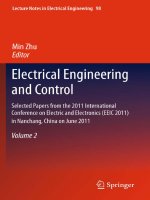Lecture Electrical Engineering: Lecture 27 - Dr. Nasim Zafar
Bạn đang xem bản rút gọn của tài liệu. Xem và tải ngay bản đầy đủ của tài liệu tại đây (921.04 KB, 46 trang )
COMSATS Institute of Information Technology
Virtual campus
Islamabad
Dr. Nasim Zafar
Electronics 1 EEE 231
Fall Semester – 2012
MOS FieldEffect Transistors
MOSFETs
Lecture No.
27
Ø
Contents:
Nasim Zafar.
2
Lecture No. 27
MOS FieldEffect Transistors
MOSFETs
Reference:
Chapter4.1
Microelectronic Circuits
Adel S. Sedra and Kenneth C. Smith.
Nasim Zafar.
3
Different Types of FETs
Ø
Junction FET (JFET)
Ø
MetalOxideSemiconductor FET (MOSFET)
Ø
MetalSemiconductor FET (MESFET)
Nasim Zafar.
4
Different Types of FETs
v
Junction FET (JFET)
The gatechannel insulator is the DEPLETION REGION,
and is the same material as the channel.
Nasim Zafar.
5
Different Types of FETs
v
MetalOxideSemiconductor FET (MOSFET)
The gatechannel insulator is made out of dielectric;SiO2
Nasim Zafar.
6
Different Types of FETs
v
MetalSemiconductor FET (MESFET)
The gate is formed by Schottky barrier to the semiconductor layer.
The gatechannel insulator consists of the DEPLETION
REGION, i.e. the same material as the channel. Very similar to the
JFET
Nasim Zafar.
7
MOS (MetalOxideSemiconductor)
Assume work function of metal and semiconductor are same.
Nasim Zafar.
8
Metal Oxide Semiconductor Field Effect Transistors
MOSFET
Nasim Zafar.
9
Circuit Symbol (NMOS)
EnhancementType
D
ID= IS
G
B (IB=0, should be reverse biased)
IG= 0
IS
S
Nasim Zafar.
GGate
DDrain
SSource
BSubstrate or Body
10
MOSFET
Voltage Controlled Current Device
MOS:
Physical
v
Nasim Zafar.
11
Introduction
Ø
Ø
Silicon is the main choice of semiconductor used. Some
other more common semiconductors such as GaAs are
not useful in MOSFETs because they do not form good
gate oxides.
In most modern MOSFETs, the gate material is heavily
doped polycrystalline silicon, sometimes referred to as
“polysilicon” or “polySi”.
–
Note that the gate is usually doped the same type as
the source/drain, i.e. the gate and the substrate are of
opposite types.
Nasim Zafar.
Ø
12
MOSFETStructure
Ø
NChannel MOSFET
The physical structure of the nchannel enhancementtype
MOSFET is shown Slide 16.
Ø
The transistor is fabricated on a ptype substance, which is a
singlecrystal silicon wafer that provides physical support for
the device.
Ø
Two heavily doped ntype regions, are created in the substrate,
indicated in the figure as:
•
n+ Source (‘S’)
•
n+ Drain (‘D’)
Nasim Zafar.
13
MOSFETStructure
Enhancement TypeNMOSFET
Body
B
(bulk or
substrate)
Gate: metal or heavily doped polySi
G
IG=0 Drain
D
Source
S
y
ID=IS
IS
Metal
n+
oxide
p
n+
x
W
L
Nasim Zafar.
14
MOSFETPhysical Structure
Figure 4.1: CrossSection. Typically L = 0.1 to 3 µm, W = 0.2 to 100
µm, and the thickness of the oxide layer (tox) is in the range of 2 to 50
nm.
Nasim Zafar.
15
MOSFETStructure (contd.)
Ø
Ø
Ø
Ø
Ø
A thin layer of silicon dioxide (SiO2) of thickness
tox(typically 250 nm) is grown on the surface of the
substrate, covering the area between the source and drain
regions.
Metal is deposited on top of the oxide layer to form the gate
electrode.
Metal contacts are also made to the source region, the drain
region, and the substrate, also known as the body.
Thus four terminals are brought out: the gate terminal (G), the
source terminal (S), the drain terminal (D), and the substrate or
body terminal (B).
Nasim Zafar.
16
To minimize current flow between the substrate (or “body”)
nChannel MOSFET –p Channel MOSFET
Ø
Ø
Ø
In an nchannel MOSFET, the channel is made of ntype
semiconductor, so the charges free to move along the channel are
negatively charged (electrons).
In a pchannel device the free charges which move from endto
end are positively charged (holes).
Nchannel and Pchannel MOSFETs operate in a complimentary
manner.
–
CMOS = Complementary MOS
Nasim Zafar.
17
MOSFETOperation
Nasim Zafar.
18
NChannel MOSFET Operation
Source Gate
n+
pSi
Drain
Gate Oxide
L
Gate Length
Bulk (Substrate)
v Current flowing through the Channel, between Source and
Drain is controlled by the Gate Voltage.
Nasim Zafar.
19
Principle of Operation
Ø
Ø
To understand the different modes of operation for an NMOS,
we consider 3 different gate bias voltages.
v
(1) below the flatband voltage, VFB
v
(2) between the flatband and the threshold voltage, VT,
v
(3) larger than the threshold voltage.
These bias regimes are called the accumulation, and depletion
mode of operation.
Nasim Zafar.
20
MOSFETOperation
Ø
Ø
Ø
Ø
The applied positive gate voltage controls the current
flow between source and drain.
This current will flow in the longitudinal direction from
drain to source in the “nchannel region.”
Note that this region has a length L and a width W.
Typically, L is in the range of 0.1 μm to 3 μm, and W is in
the range of 0.2 μm to 100 μm.
MOSFET is a symmetrical device; thus its source and
drain can be interchanged with no change in the device
characteristics.
Nasim Zafar.
21
NChannel MOSFET Operation
S
n+
pSi
G
v VGS applied (positive)
Gate Oxide v Both VGS and VDS applied
D
L
Gate Length
(Substrate)
v
The applied positive gate voltage controls the current flow between
source and drain.
Nasim Zafar.
22
MOSFETOperation
Operation with No Gate Voltage:
v
v
v
(1) VGS = 0, and VS = VD =0
With no voltage applied to the gate, two backtoback
diodes exist in series between drain and source.
No current flows even if vDS is applied. These backto
back diodes prevent current conduction from drain to
source.
Nasim Zafar.
v
23
MOSFETOperation
Operation with Applied Gate Voltage:
v
Formation of n
Channel for Current
Flow:
Nasim Zafar.
24
MOSFETOperation (contd.)
Operation with Applied Gate Voltage:
v
v
(2) VGS > 0, and VS = VD =0
First, the holes are repelled by the
positive gate voltage, leaving
behind negative acceptor ions and
forming a depletion region (slide
25
26b). Nasim Zafar.









